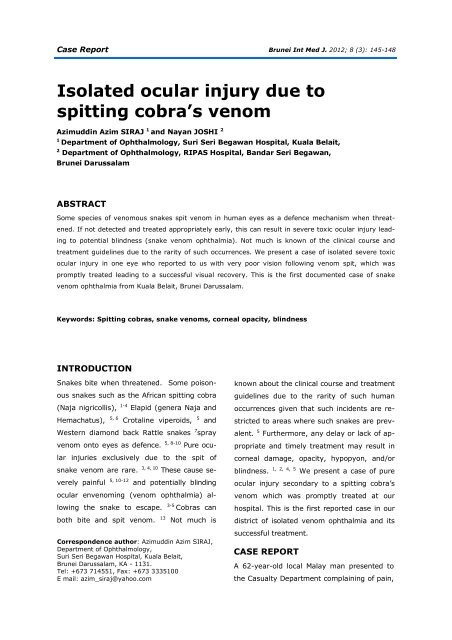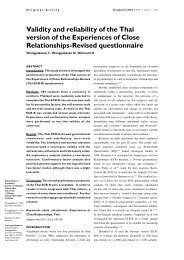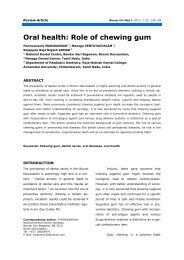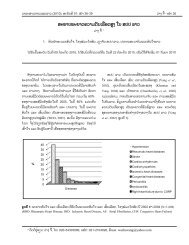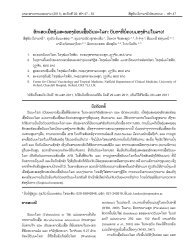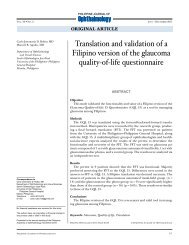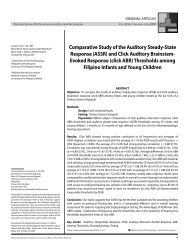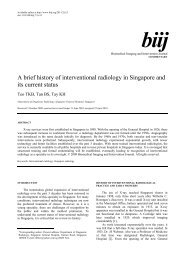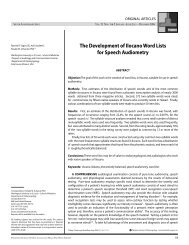You also want an ePaper? Increase the reach of your titles
YUMPU automatically turns print PDFs into web optimized ePapers that Google loves.
Case Report<br />
Brunei Int Med J. 2012; 8 (3): 145-148<br />
Isolated ocular injury due to<br />
spitting cobra’s venom<br />
Azimuddin Azim SIRAJ 1 and Nayan JOSHI 2<br />
1<br />
Department of Ophthalmology, Suri Seri Begawan Hospital, Kuala Belait,<br />
2 Department of Ophthalmology, RIPAS Hospital, Bandar Seri Begawan,<br />
Brunei Darussalam<br />
ABSTRACT<br />
Some species of venomous snakes spit venom in human eyes as a defence mechanism when threatened.<br />
If not detected and treated appropriately early, this can result in severe toxic ocular injury leading<br />
to potential blindness (snake venom ophthalmia). Not much is known of the clinical course and<br />
treatment guidelines due to the rarity of such occurrences. We present a case of isolated severe toxic<br />
ocular injury in one eye who reported to us with very poor vision following venom spit, which was<br />
promptly treated leading to a successful visual recovery. This is the first documented case of snake<br />
venom ophthalmia from Kuala Belait, Brunei Darussalam.<br />
Keywords: Spitting cobras, snake venoms, corneal opacity, blindness<br />
INTRODUCTION<br />
Snakes bite when threatened. Some poisonous<br />
snakes such as the African spitting cobra<br />
(Naja nigricollis), 1-4 Elapid (genera Naja and<br />
Hemachatus), 5, 6 Crotaline viperoids, 5 and<br />
Western diamond back Rattle snakes 7 spray<br />
venom onto eyes as defence. 5, 8-10 Pure ocular<br />
injuries exclusively due to the spit of<br />
snake venom are rare. 3, 4, 10 These cause severely<br />
painful<br />
5, 10-12<br />
and<br />
potentially blinding<br />
ocular envenoming (venom ophthalmia) allowing<br />
the snake to escape. 3-5 Cobras can<br />
both bite and spit venom. 13<br />
Not much is<br />
Correspondence author: Azimuddin Azim SIRAJ,<br />
Department of Ophthalmology,<br />
Suri Seri Begawan Hospital, Kuala Belait,<br />
Brunei Darussalam, KA - 1131.<br />
Tel: +673 714551, Fax: +673 3335100<br />
E mail: azim_siraj@yahoo.com<br />
known about the clinical course and treatment<br />
guidelines due to the rarity of such human<br />
occurrences given that such incidents are restricted<br />
to areas where such snakes are prevalent.<br />
5 Furthermore, any delay or lack of appropriate<br />
and timely treatment may result in<br />
corneal damage, opacity, hypopyon, and/or<br />
blindness.<br />
1, 2, 4, 5<br />
We<br />
present a case of pure<br />
ocular injury secondary to a spitting cobra’s<br />
venom which was promptly treated at our<br />
hospital. This is the first reported case in our<br />
district of isolated venom ophthalmia and its<br />
successful treatment.<br />
CASE REPORT<br />
A 62-year-old local Malay man presented to<br />
the Casualty Department complaining of pain,
SIRAJ and JOSHI. Brunei Int Med J. 2012; 8 (3): 146<br />
a<br />
b<br />
Fig. 1: a) Anterior segment colour photograph of the right eye (at presentation) showing evidence of acute<br />
necrosis of the corneal epithelium (black arrow) and widespread epithelial damage. Anterior segment<br />
details are not clear. Fig. 1; b) Anterior segment colour photograph of the unaffected left eye showing<br />
clear anterior segment.<br />
irritation, severe burning sensation and blurring<br />
of vision in his right eye (RE). Apparently,<br />
while gardening without any protective<br />
eye wear, he stumbled upon a black cobra at<br />
close range. When challenged, it raised its<br />
hood and suddenly spat venom into his RE.<br />
The victim was familiar with snake morphology<br />
and hence promptly identified the snake<br />
as a cobra. It was about three feet long and<br />
about three feet away from the victim when it<br />
spat venom. He was immediately rushed to<br />
the hospital.<br />
Upon evaluation, his vitals were stable.<br />
There were no adnexial inflammatory<br />
signs. His RE vision was counting fingers at<br />
two metres and his Left eye (LE) vision was<br />
6/9 (Pin hole). His intraocular pressures were<br />
digitally normal in both eyes (BE). The RE<br />
cornea was hazy (Figure 1a). Flourescein<br />
staining of the right cornea was positive revealing<br />
epithelial damage. There was evidence<br />
of toxic necrosis of the corneal epithelium<br />
with circumciliary and conjunctival congestion.<br />
There was no chemosis, limbal ischaemia<br />
or necrosis. Due to the corneal haze,<br />
his anterior chamber and fundus details were<br />
not clear. LE evaluation was normal (Figure<br />
1b). Extra-ocular movements and convergence<br />
were intact. There was no associated<br />
cranial nerve palsy. Systemic evaluation was<br />
normal.<br />
His eyes were immediately irrigated<br />
with balance salt solution (BSS, Alcon) for<br />
approximately 20 minutes. Blood investigations<br />
including coagulation profile and renal<br />
profiles were normal. He was admitted to the<br />
medical ward for observation and treatment<br />
of possible effects of systemic absorption. He<br />
was treated with topical antibiotic (G. Ciprofloxacin)<br />
eye drops six times daily, antiinflammatory<br />
drops (G. Dexamethasone with<br />
neomycin and polymyxin B sulphate) four<br />
times daily, cycloplegics (G. Homatropine<br />
2%) twice daily, intraocular pressure lowering<br />
agents (G. Timolol Maleate 0.5 %) twice daily<br />
and Tetracycline eye ointment twice daily to<br />
his RE.<br />
As there were no signs of systemic<br />
venom absorption and normal blood parameters,<br />
the patient was discharged and continued<br />
on topical medications in his RE.
SIRAJ and JOSHI. Brunei Int Med J. 2012; 8 (3): 147<br />
On clinic review, he was asymptomatic<br />
five days after starting the treatment. The<br />
RE vision improved to 6/7.5 with clear cornea,<br />
negative flourescein staining and no<br />
conjunctival congestion (Figure 2). The left LE<br />
examination remained the same. His topical<br />
medications were tapered, and he was asked<br />
to attend for follow-up periodically to monitor<br />
for any late sequelae.<br />
DISCUSSION<br />
Pure snake venom ophthalmia is rare and is<br />
often restricted to regions where these<br />
snakes are found. 3, 4, 10 Even then, such occurrence<br />
is considered uncommon. PubMed<br />
search revealed several reports from the<br />
Southeast Asian region. 8, 10, 11 To our knowledge,<br />
there had only been one reported case<br />
of snake venom ophthalmia from Brunei Darussalam.<br />
This was a case of a 40-year-old<br />
man who was treated with copious irrigation<br />
and topical antibiotic. 14 Our case is the first<br />
reported case from Kuala Belait which differed<br />
from the reported literature in that the<br />
patient did not have any soft tissue inflammation,<br />
necrosis or facial nerve palsy. 5<br />
Spitting snakes maximise damage by<br />
spraying the venom on the victims face tar–<br />
geting their eyes by fast undulating head<br />
movements while spewing the venom, thereby<br />
increasing the coverage area. 8 When the<br />
spit snake’s venom comes in contact with the<br />
ocular structures, local inflammatory responses<br />
like periocular soft tissue swelling,<br />
local necrosis, 2-5 conjunctival erythema,<br />
1, 2, 9, 10<br />
4, 11<br />
chemosis, 2, 6 corneal oedema, 2 epithelial<br />
erosion 2, 11 , corneal ulcer, 3, 4 anterior uveitis,<br />
4 hypopyon, 5 and subsequent corneal scarring<br />
occur which could result in permanent<br />
blindness.<br />
2, 4, 9<br />
Our<br />
patient had pain, irritation<br />
and conjunctival congestion with evidence<br />
of corneal epithelial toxic necrosis in<br />
the RE (Figure 1).<br />
The local damage caused by the venom<br />
is due to cytotoxins 4 and cardiotoxins 6<br />
which could cause corneal opacification and<br />
blindness. 15 The local corneal changes are<br />
due to histamine, acetylcholine, and endogenous<br />
corneal damaging factors. 2 Systemic<br />
envenoming following local spit has not been<br />
reported in humans. 5 Cobra venom can<br />
cause blindness also by biting, causing bilateral<br />
optic neuritis and cortical blindness. 13<br />
The mainstay of venom ophthalmia treatment<br />
is prompt, copious and continuous irrigation<br />
with fluids. 1, 3-5, 7, 12 In addition, topical antibiotics<br />
4-6 , topical heparin 2, 6, 9, 10, , and cycloplegics<br />
5 , have been recommended. The role<br />
of topical anti-snake venoms is controversial.<br />
9, 11<br />
Some studies favour it while others did<br />
not find any benefit. 5 The use of steroids has<br />
not been routinely recommended. 2, 5 While<br />
one study did not recommend topical ster–<br />
oids and tetracycline ophthalmic ointment<br />
based on a rabbit model 9 , another study rec-<br />
Fig. 2: Anterior segment photograph of the affected<br />
eye showing complete healing of the corneal epithelium<br />
and the anterior segment details are now<br />
clear (after five days of treatment).<br />
ommended tetracycline ophthalmic ointment<br />
as it had been found to reduce the extent of<br />
corneal scarring in humans. 6 Our case was
SIRAJ and JOSHI. Brunei Int Med J. 2012; 8 (3): 148<br />
treated in accordance with reported literature<br />
by copious and continuous irrigation of the<br />
eye. 1, 3-5, 7, 12 Since we could not rule out any<br />
occult intraocular inflammation due to impaired<br />
visualisation secondary to corneal<br />
changes, cycloplegics (G. Homatropine 2%<br />
BD) and topical steroids-antibiotic eye drops<br />
(G. neomycin sulphate equivalent to neomycin<br />
3.5mg, polymyxin B sulphate 10,000<br />
units, dexamethasone 0.1% QID) were instilled.<br />
In addition, topical antibiotic drops (G.<br />
Ciprofloxacin six times a day) and tetracycline<br />
eye ointment 6 BD were administered.<br />
Intraocular pressure lowering medication (G.<br />
timolol Maleate 0.5 % BD) was added to control<br />
any possible secondary post inflammatory<br />
intraocular pressure spike. Topical heparin<br />
drops and anti-snake venom were not used in<br />
this patient.<br />
We report this case in view of its rarity<br />
and unique presentation, and to highlight<br />
the importance of systematic evaluation and<br />
prompt referral. A timely and properly performed<br />
continuous irrigation removes the<br />
maximal toxic load from the eye and reduces<br />
the ocular complications.<br />
REFERENCES<br />
1: Goldman DR, Seefeld AW. Ocular toxicity associated<br />
with indirect exposure to African spitting cobra<br />
venom. Wilderness Environ Med. 2010; 21:134-6.<br />
Epub 2009.<br />
2: Ismail M, Ellison AC. Ocular effects of the venom<br />
from the spitting cobra (Naja nigricollis). J Toxicol<br />
Clin Toxicol. 1986; 24:183-202.<br />
3: Warrell DA, Ormerod LD. Snake venom ophthalmia<br />
and blindness caused by the spitting cobra<br />
(Naja nigricollis) in Nigeria. Am J Trop Med Hyg.<br />
1976; 25:525-9.<br />
4: Petras D, Sanz L, Segura A, et al. Snake venomics<br />
of African spitting cobras: toxin composition and<br />
assessment of congeneric cross-reactivity of the<br />
pan-African EchiTAb-Plus-ICP antivenom by antivenomics<br />
and neutralization approaches. J Proteome<br />
Res. 2011; 10:1266-80.<br />
5: Chu ER, Weinstein SA, White J, et al. Venom<br />
ophthalmia caused by venoms of spitting elapid<br />
and other snakes: Report of ten cases with review<br />
of epidemiology, clinical features, pathophysiology<br />
and management. Toxicon. 2010; 56:259-72.<br />
6: Ismail M, al-Bekairi AM, el-Bedaiwy AM, et al.<br />
The ocular effects of spitting cobras: I. The ringhals<br />
cobra (Hemachatus haemachatus) venom-induced<br />
corneal opacification syndrome. J Toxicol Clin Toxicol<br />
1993; 31:31-41.<br />
7: Troutman WG, Wilson LE. Topical ophthalmic<br />
exposure to rattlesnake venom. Am J Emerg;<br />
7:307-8.<br />
8: Westhoff G, Tzschätzsch K, Bleckmann H. The<br />
spitting behavior of two species of spitting cobras. J<br />
Comp Physiol A Neuroethol Sens Neural Behav<br />
Physiol 2005; 191:873-81.<br />
9: Cham G, Pan JC, Lim F, et al. Effects of topical<br />
heparin, antivenom, tetracycline and dexamethasone<br />
treatment in corneal injury resulting from<br />
the venom of the black spitting cobra (Naja sumatrana),<br />
in a rabbit model. Clin Toxicol (Phila) 2006;<br />
44:287-92.<br />
10: Tan HH. Epidemiology of snakebites from a<br />
general hospital in Singapore: a 5-year retrospective<br />
review (2004-2008). Ann Acad Med Singapore<br />
2010; 39:640-7.<br />
11: Fung HT, Lam KK, Wong OF, et al. Local antivenom<br />
treatment for ophthalmic injuries caused by<br />
a Naja atra. J Med Toxicol 2010; 6:147-9.<br />
12: Rouvin B, Kone M, N'diaye M, et al. Spitting<br />
cobras: description of 2 cases in Djibouti. Med<br />
Trop. 2010; 70:95-6.<br />
13: Berger RR, Brook S. Cobra bite: ophthalmic<br />
manifestations. Harefuah 1993; 125:265-6, 327-8.<br />
14: Raja SA, Kok KY, Snake venom ophthalmia.<br />
Brunei Int Med J. 2011; 7:332-5.<br />
15: Ismail M, al-Bekairi AM, el-Bedaiwy AM, et al.<br />
The ocular effects of spitting cobras: II. Evidence<br />
that cardiotoxins are responsible for the corneal<br />
opacification syndrome. J Toxicol Clin Toxicol 1993;<br />
31:45-62.


